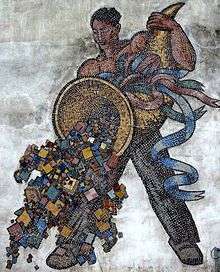Frans Masereel

Frans Masereel (31 July 1889 – 3 January 1972) was a Flemish painter and graphic artist who worked mainly in France. He is known especially for his woodcuts. His greatest work is generally said to be the wordless novel Passionate Journey. He completed over 20 other wordless novels in his career.
Masereel's woodcuts had an important influence on the work of Lynd Ward and later graphic artists such as Clifford Harper and Eric Drooker. There is a Frans Masereel Centre (Frans Masereel Centrum for Graphix) in the village of Kasterlee in Belgium.
Biography
Frans Masereel was born in the Belgian coastal city Blankenberge on 31 July 1889. He moved to Ghent in 1896, where he began to study at the École des Beaux-Arts in the class of Jean Delvin at the age of 18.[1] In 1909 he went on trips to England and Germany, which inspired him to create his first etchings and woodcuts. In 1911 Masereel settled in Paris for four years and then emigrated to Switzerland, where he worked as a graphic artist for journals and magazines.

At the end of World War I Masereel was prevented from returning to his home country Belgium since as a pacifist he had refused to serve in the Belgian army. When a circle of friends interested in art and literature based in Antwerp decided to found the magazine 'Lumière', Masereel was one of the artists invited to illustrate the text and the column headings. The magazine was first published in Antwerp in August 1919.[2] The magazine was an artistic and literary journal published in French. The magazine's title 'Lumière' was a reference to the French magazine 'Clarté', that was published in Paris by Henri Barbusse.[3] The principal five artists who illustrated the text and the column headings were, in addition to Masereel himself, Jan Cantré, Jozef Cantré, Henri van Straten and Joris Minne. They became known as 'De Vijf' or 'Les Cinq' ('The Five').[4] The magazine 'Lumière' was a key force in generating renewed interest in wood engraving in Belgium. The five artists in 'De Vijf' group were instrumental in popularizing the art of wood, copper and linoleum engraving and introducing Expressionism in early 20th-century Belgium.[2][5]
Masereel's woodcut series, mainly of sociocritical content and of expressionistic form concept, made Masereel internationally known. Among these were the wordless novels 25 Images of a Man's Passion (1918), Passionate Journey (1919), The Sun (1919), The Idea (1920) and Story Without Words (1920). At that time Masereel also drew illustrations for famous works of world literature by Thomas Mann, Émile Zola and Stefan Zweig.

In 1921 Masereel returned to Paris, where he painted his famous street scenes, the Montmartre paintings. He lived for a time in Berlin, where his closest creative friend was George Grosz. After 1925 he lived near Boulogne-sur-Mer, where he painted predominantly coast areas, harbour views, and portraits of sailors and fishermen. During the 1930s his output declined. In 1940 he fled from Paris and lived in several cities in Southern France.
At the end of World War II Masereel was able to resume his artistic work and produced woodcuts and paintings. After 1946 he worked for several years as a teacher at the Hochschule der Bildenden Künste Saar in Saarbrücken. In 1949 Masereel settled in Nice.[1] In the following years until 1968 several series of woodcuts were published, which differ from his earlier "novels in picture'" in comprising variations of a subject instead of being a continuing narrative. He also designed decorations and costumes for numerous theatre productions. The artist was honoured in numerous exhibitions and became a member of several academies. Frans Masereel died in Avignon in 1972 and was entombed in Ghent. The cultural organization Masereelfonds was named after him.
Influence
Masereel's woodcuts had an important influence on the work of Lynd Ward and later graphic artists such as George Walker, Clifford Harper and Eric Drooker.
List of works
Wordless novels
- 25 Images of a Man's Passion (1918)
- Passionate Journey (1919)
- The Sun (1919)
- Story Without Words (1920)
- The Idea (1920)
- The City (1925)
- The Work (1928)
- The Siren (1932)
- From Black to White (1939)
- Danse Macabre (1941)
- Route des hommes (1964)
References
- 1 2 Lambiek Comiclopedia. "Frans Masereel".
- 1 2 Joos Florquin, 'Ten huize van... 1', Davidsfonds, Leuven / Orion - Desclée De Brouwer, Bruges, 971, p. 270-299 (Dutch)
- ↑ Peter Brooker, Sascha Bru, Andrew Thacker, Christian Weikop, 'The Oxford Critical and Cultural History of Modernist Magazines: Europe 1880 - 1940', Oxford University Press, 19 May 2013, p. 330-331
- ↑ Modernist wood cut prints of Joris Minne
- ↑ PASSINGS : Joris Minne; Belgian Helped Revive Art of Engraving, April 02, 1988, Los Angeles Times
Further reading
- Davide Di Maio: I romanzi per immagini di Masereel, in «Wuz», n. 1, gennaio-febbraio 2005, pp. 34–43.
- Kaplan, Arie (2008). From Kraków to Krypton: Jews and Comic Books. Jewish Publication Society. ISBN 978-0-8276-0843-6.
External links
| Wikimedia Commons has media related to Frans Masereel. |
- Frans Masereel Foundation site (German)
- International Institute of Social History, Amsterdam, Netherlands
- Nebulous Cargo - an observant walk through modern ruins
- Frans Masereel Centre, Artist in Residence - Belgium
- Politische Zeichnungen on the Internet Archive
| ||||||||||||||
|